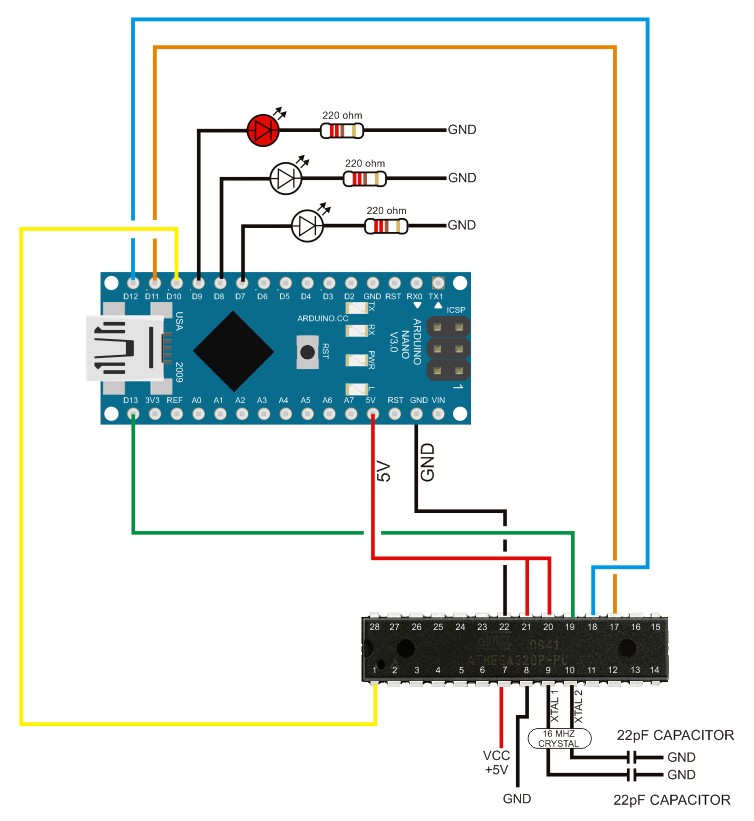

- 27C801 EPROM PROGRAMMER ARDUINO HOW TO
- 27C801 EPROM PROGRAMMER ARDUINO UPDATE
- 27C801 EPROM PROGRAMMER ARDUINO PORTABLE
get ( EEAddr, miny ) EEAddr += sizeof ( miny ) ĮEPROM. get ( EEAddr, maxx ) EEAddr += sizeof ( maxx ) ĮEPROM. get ( EEAddr, minx ) EEAddr += sizeof ( minx ) ĮEPROM. println ( "EEPROM variable read and write." ) ĮEPROM. Static unsigned int minx, maxx, miny, maxy #define EEADDR 166 // Start location to write EEPROM data. When you hit the button you can also see write execution time. These same numbers are displayed (having been read from the EEPROM). Retrieve the values simply press the reset button on the Arduino and When you push the button random values are saved to the EEPROM. On start up the EEPROM values are retrieved from the EEPROM and Just attach a push button connected to ground and pin 5 of theĪrduino. The Idea here is to store a set of simple type variables sequentially in the EEPROM at a specific EEPROM address. You just want to select from a set of previously saved data. (and you don't want to recompile each time just to change a few This is especially useful for a system where you are trying out different options Single struct objects to/from EEPROM but quite often want to switchĭata (or store more than just a single variable). The previous member functions are useful for writing single bytes or The upshot is, if you bundle your data into a structure then it is easy to put and get it, to and from EEPROM. If variables inside) then it will write a variable of this type toĮEPROM without you having to know the number of bytes that the type The really useful point about this function is that it can also write
27C801 EPROM PROGRAMMER ARDUINO PORTABLE
So this function is portable across different compilers (that use Type object without knowing the number of bytes used by the type object. You can use this function to write out an char, int, long or float In addition it measures the size of the data type being used to write
27C801 EPROM PROGRAMMER ARDUINO UPDATE
The put function writes out a set of bytes using the update function. It is Ok writing bytes, but there's an easier way to write a set ofĭata to the EEPROM and that us by using the put function (get is the The only reason not to do so, is that it must perform a readįirst so it will be slower than an EEPROM.write operation. Really, this is the function you should use to preserve the EEPROM Wearing out EEPROM if you try and write the same byte to the EEPROM. This function will only perform a write operation if the current To read and write these bytes you can use the following functions: The basic unit of an EEPROM transaction is a byte. If there are multipleįailures then generate an error e.g an message to a screen or light aĪ write of one byte takes 3.3ms - however it seems faster (see output from programs below).Īrduino EEPROM functions EEPROM Read and Write Bytes TIP: Each time you write a set of data - read it back to ensure it It is the same as the value you want to write, then don't write to it! TIP: To extend EEPROM life first read the contents to be written - if You can read an EEPROM address as many times as you want. Note: Reading from the EEPROM does not degrade the memory. Never write to the same address in EEPROM memory from within a for loop! Alternatively update parameters on brown-out detection or power down initiation. For instance if a user starts a calibration sequence. The solution they chose was to move the starting write address afterĮvery block of data was written so that the same area of EEPROM was notĬontinuously used Extending the life of the EEPROM.Ī better way is to make sure you only write to the EEPROM at aĭefined time. Lifetime of the EEPROM it was written so much that the EEPROM wore out. Problem was that the data was always written every time round the program loop, so even with the huge Same location to save data as parameters changed. The EEPROM was being written continuously to the

I was once at a firm that managed to have their units randomly fail. Parameters or current instrument settings. The program itself will update EEPROM for saving parameters that are requiredīetween power up and power down. In reality EEPROM is use differently to FLASH memory, since an EEPROM isĭesigned for updated data. Using the EEPROM 10 times a day the EEPROM life will be 100000/10 # 10000 Days or 27 Years! Program every day and you will use a new device for new projects, so it It turns out that it will last at leastġ0000.0/10.0 = 1000 Days or 2.7 years). Normal Flash memory will last if you write to it 10 times per day.
27C801 EPROM PROGRAMMER ARDUINO HOW TO


 0 kommentar(er)
0 kommentar(er)
